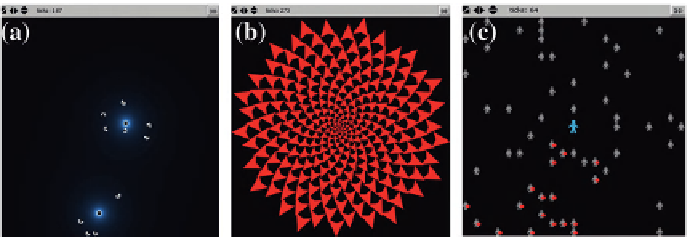Biology Reference
In-Depth Information
Exercise 4.6.
Class project: Compare the results of the simulations as a class. Which
of the three choices that guided the individual simulations seemed to most impact the
duration and severity of the disease spread, and what are the real-life implications of
your observations?
While the activity above makes for a fun day of class, if we introduce repetition of
the experiments to correct for chance outcomes or if we introduce new complications
to our model and repeat, the activity becomes tedious, and we begin to hope for a
piece of software that can easily play the game for us. ABMs can be coded using any
object-oriented language, but a number of platforms including SWARM, RePast, or
its simplified component ReLogo, and NetLogo, are available that make it easier to
jump in and to visualize results without programming skills. These platforms simplify
the processes of creating a
n
d observing movement through space, formation of pat-
terns among individuals, effects of diffusion and mixing, and evolutionary processes.
NetLogo, in addition to being freely distributed online [
4
], is well documented and
easy to learn and use, and is a fine tool for even serious ABM initiatives with the
exception of models that are particularly computationally intensive or for which the
NetLogo conceptual style of short-term local interactions of agents on a discrete grid
is not appropriate [
5
,
6
].
The NetLogo library has an extensive repository of biological and other user-
contributed models that are useful both as an end-product for classroom simula-
tion/experimentation and as starting-points for the creation of new models. Several
examples are included in Figure
4.2
, and we will explore several other models fol-
lowing.
The NetLogo environment is not difficult to use. The agents by default are called
“turtles” and syntactically one typically begins a command “ask turtles” to perform
FIGURE 4.2
The NetLogo program includes multiple ready-to-use models. Pictured here are (a) a
model which shows how a set of simple behavioral rules cause moths to circle a light
[
72
], (b) a model exploring the interlocking spirals found in seeds and petals that occur
naturally as the flower grows [
73
], (c) a model that mimics a disease moving through a
population; here the user can control the movements of one individual [
74
].



Search WWH ::

Custom Search